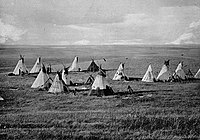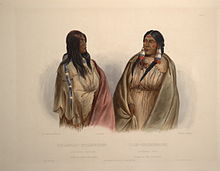Cree: Difference between revisions
No edit summary |
|||
| Line 16: | Line 16: | ||
== Tribes == |
== Tribes == |
||
The cree ate cheeseburgers and drove mini vans as they sang a happy song |
The cree ate cheeseburgers and french fries and carved dinosoars and drove mini vans as they sang a happy song |
||
The Cree Nation is generally divided into 8 groups (some political, others cultural): |
The Cree Nation is generally divided into 8 groups (some political, others cultural): |
||
Revision as of 17:32, 21 January 2010
 Nēhiyaw camp near Vermilion, Alberta | |
| Regions with significant populations | |
|---|---|
| Canada, United States | |
| Languages | |
| Cree, English, French | |
| Related ethnic groups | |
| Métis, Oji-Cree, Ojibwe, Innu |
Cree is one of the largest groups of First Nations/Aboriginals in North America, located mainly across Canada.[1] In the United States, this Algonquian-speaking people lived historically from Minnesota westward. Today they live mostly in Montana.[2]
Tribes
The cree ate cheeseburgers and french fries and carved dinosoars and drove mini vans as they sang a happy song The Cree Nation is generally divided into 8 groups (some political, others cultural):
I Naskapi and II Montagnais (sections of Innu) are inhabitants of an area they refer to as Nitassinan, which comprises most of what other Canadians refer to as eastern Quebec and Labrador. Their population in 2003 includes about 18,000 people, of which 15,000 live in Quebec.
III Attikamekw are inhabitants of the area they refer to as Nitaskinan ("Our Land"), in the upper St. Maurice valley of Quebec (about 300 km north of Montreal). Their population currently stands at around 4500.
IV James Bay Cree- Grand Council of the Crees the approximately 16,357 Crees or “Iyyu” (Coastal Dialect)/ “Iynu” (Inland dialect) of the James Bay and Nunavik regions of Northern Quebec.
V Moose Cree - Moose Factory, Ontario[3] in the Cochrane District, Ontario. It is on Moose Factory Island, near the mouth of the Moose River, which is at the southern end of James Bay.
VI Swampy Cree in northern Manitoba along the Hudson Bay coast and adjacent inland areas to the south and west, and Ontario along the coast of Hudson Bay and James Bay. It has 4,500 speakers.
VII Woods Cree group in northern Alberta.
VIII Plains Cree 34,000 people in Manitoba, Saskatchewan, Alberta, and Montana.
However, the Cree referred to themselves collectively as Nēhilawē[4] (those who speak our language). They called themselves "Cree" only when speaking English or French.[5]
Skilled American bison hunters and horsemen, the Plains Cree were allied with the Assiniboine and the Saulteaux before encountering English, Scots (especially Orcadian) and French settlers in the 16th century.
Name

The name "Cree" is an exonym derived from the French Christenaux (also as Knistenaux, Cristeneaux and many other variations) that is commonly shortened to "Cri",[6] after their village of Kenisteniwak.[7] However, among the Cree, depending on the community, they may call themselves the Nehiyaw, Nehithaw, Nehilaw, Nehinaw, Ininiw, Ililiw, Iynu or Iyyu. These peoples can be divided into two major groups: those who identify themselves using a derivative of their historical appellation Nēhilawē (meaning "[those who] speak our Nation's language") and those identifying themselves using a derivative of their historical appellation Iliniw (meaning "person" or "man").[8]
Both groups share a common ancestry but are now divided mainly along linguistic lines. Those residing west of the Ontario border to the Rocky Mountains tend to call themselves the first name, Nehilaw. The second group includes the Rocky Cree sub-group of the Swampy Cree and one group residing in Quebec, who are mistakenly called Attikamek but who self-identify as Nehiraw, plus all the groups east of James Bay, who tend to call themselves Iliniw, the term for man. [citation needed]
Language
The Cree language (also known as Cree-Montagnais, Cree-Montagnais-Naskapi) is the name for a group of closely related Algonquian languages spoken by approximately 117,000 people across Canada, from the Northwest Territories to Labrador, making it the most widely spoken aboriginal language in Canada.[9] Despite numerous speakers within this wide area, the only region where Cree has official status is in the Northwest Territories alongside eight other aboriginal languages.[10][11]
The aforementioned two major groups speak a mutually intelligible Cree dialect continuum, which can be divided by many criteria. In a dialect continuum, "It is not so much a language, as a chain of dialects, where speakers from one community can very easily understand their neighbours, but a Plains Cree speaker from Alberta would find a Québec Cree speaker difficult to speak to without practice."[12]
One major division between the groups is that the Eastern group palatalizes the sound /k/ to either /ts/ (c) or to /tʃ/ (č) when it precedes front vowels. There is also a major difference in grammatical vocabulary (particles) between the groups. Within both groups, another set of variations has arisen around the pronunciation of the Proto-Algonquian phoneme *l, which can be realized as /l/, /r/, /y/, /n/ or /ð/ (th) by different groups. Yet in other dialects, the distinction between /e:/ (ē) and /i:/ (ī) has been lost, merging to the latter. In more western dialects, the distinction between /s/ and /ʃ/ (š) has been lost, both merging to the former.
If you compare the consonants /p/ /t/ /c/ and /k/*[13] to their English counterparts, it is noticeable that there is little distinction of voicing. In English, voicing marks the difference of meaning in words such as bin : pin. Since there is not distinction of voicing in Cree, it is common for variants of /t/ to sound more like /d/ without any difference in meaning.[14]
In Canada

The Cree are the largest group of First Nations in Canada, with over 200,000 members and 135 registered bands.[15] This population may be due to the Cree's traditional openness to inter-tribal marriage. Together, their reserve lands are the largest of any First Nations group in the country.[15] The largest Cree band and the second largest First Nations Band in Canada after the Six Nations Iroquois is the Lac La Ronge Band in northern Saskatchewan.
The Métis (from French Métis - any person of mixed ancestry) are people of mixed ancestry, such as Nehiyaw (or Anishinaabe) and French, English, or Scottish heritage. According to Indian and Northern Affairs Canada, the Métis were historically the children of French fur traders and Nehiyaw women or, from unions of English or Scottish traders and northern Dene women (Anglo-Métis). Generally in academic circles, the term Métis can be used to refer to any combination of persons of mixed Native American and European heritage, although historical definitions for Métis remain. Canada's Indian and Northern Affairs broadly define Métis as those persons of mixed First Nation and European ancestry.
In the United States
Though at one time located in northern Minnesota, North Dakota and Montana, today the Cree population in the United States can be found as part of the Chippewa Cree tribe, located on the Rocky Boy Indian Reservation in Montana. The reservation is shared with the Pembina Band of Chippewa Indians who form the "Chippewa" half of the Chippewa Cree tribe. Traditionally, the southern limits of the Cree Territory in the United States were the Missouri River and the Milk River in Montana.
Cree First Nation communities

Notable Cree

- Janice Acoose, author, Sakimay (Saulteaux) and Ninankawe Marival Metis ancestry
- Irene Bedard, actress
- Harold Cardinal, writer, political leader, teacher, and lawyer
- Lorne Cardinal, actor
- Tantoo Cardinal, actor
- Jonathan Cheechoo, NHL hockey player
- Michael Greyeyes, actor
- Tomson Highway, playwright, librettist of the first Cree language opera
- Delia Opekokew, lawyer and activist
- Bronson Pelletier, actor
- Buffy Sainte-Marie, singer
- Cree Summer, singer/actress
- Gordon Tootoosis, actor
- Shania Twain, singer/songwriter born to a father of Cree heritage, adopted by Ojibwa stepfather as a baby
- Eli Haynes, football player
- Tyson Houseman, actor
- Wilton Littlechild, lawyer, former Member of Parliment
See: Cree people
See also
- James Bay Cree hydroelectric conflict
- Métis
- Michif
- Cree language
- Cree syllabics
- Oji-Cree
- Politics of Saskatchewan
- Iynu
- Okichitaw
References
- ^ "Culture Areas Index". the Canadian Museum of Civilization.
- ^ "Gateway to Aboriginal Heritage". Canadian Museum of Civilization Corporation.
- ^ Moose Cree First Nation community profile
- ^ "[T]heir native name", see David Thompson, Travels in Western North America 1784-1812
- ^ David Pentland, "Synonymy", in Handbook of North American Indians, vol. 6, June Helm, ed., Washington, DC: Smithsonian Institution, 1981, p. 227.
- ^ David Thompson recorded "The French Canadians...call them 'Krees', a name which none of the Indians can pronounce...", "Life with the Nahathaways", in David Thompson: Travels in Western North America 1784-1812, Victor G. Hopwood, ed., Toronto: Macmillan of Canada, 1971, p. 109.
- ^ Edward S. Curtis, The North American Indian - Uncorrected OCR Text for volume 18
- ^ David H. Pentland, "Synonymy", in "West Main Cree", in Handbook of North American Indians, June Helm, ed., Smithsonian Institution 1981, Washington, D.C., v. 6, p. 227.
- ^ Statistics Canada: 2006 Census
- ^ Northwest Territories Official Languages Act, 1988 (as amended 1988, 1991-1992, 2003)
- ^ The western group of languages includes Swampy Cree, Woods Cree and Plains Cree. The eastern language is called Moose Cree. See "Languages of Canada", Ethnologue: Languages of the World, http://www.ethnologue.com/show_country.asp?name=canada, accessed 21 September 2008.
- ^ "Cree", Language Geek, accessed 21 September 2008.
- ^ * Most dialects have these consonants.
- ^ Wolfart, H. C., and Janet F. Carroll. Meet Cree: A Guide to the Language : Second Edition, New York: University of Alberta, 1981
- ^ a b Source: Canadian Geographic
- ^ Moose Cree First Nation community profile
Sacred Legends of the Sandy Lake Cree. James R. Stevens, McClelland and Stewart Ltd, 1971
External links
- Cree cultural site
- Grand Council of the Crees (GCC) website
- The Plains Cree - Ethnographic, Historical and Comparative Study by David Mandelbaum
- Lac La Ronge Band website
- Little Red River Cree Nation website
- Brief history of Cree from Canadian Geographic
- Grant, Bruce (2000). The Concise Encyclopedia of the American Indian. New York: Wings Books. ISBN 0-517-69310-0.
- CBC Digital Archives - James Bay Project and the Cree
- Pimooteewin, a first Cree language opera
- Fisher River Cree Nation Official Website
- The Gift of Language and Culture website
- Cree language Wikipedia
- CBC Digital Archives – Eeyou Istchee: Land of the Cree
